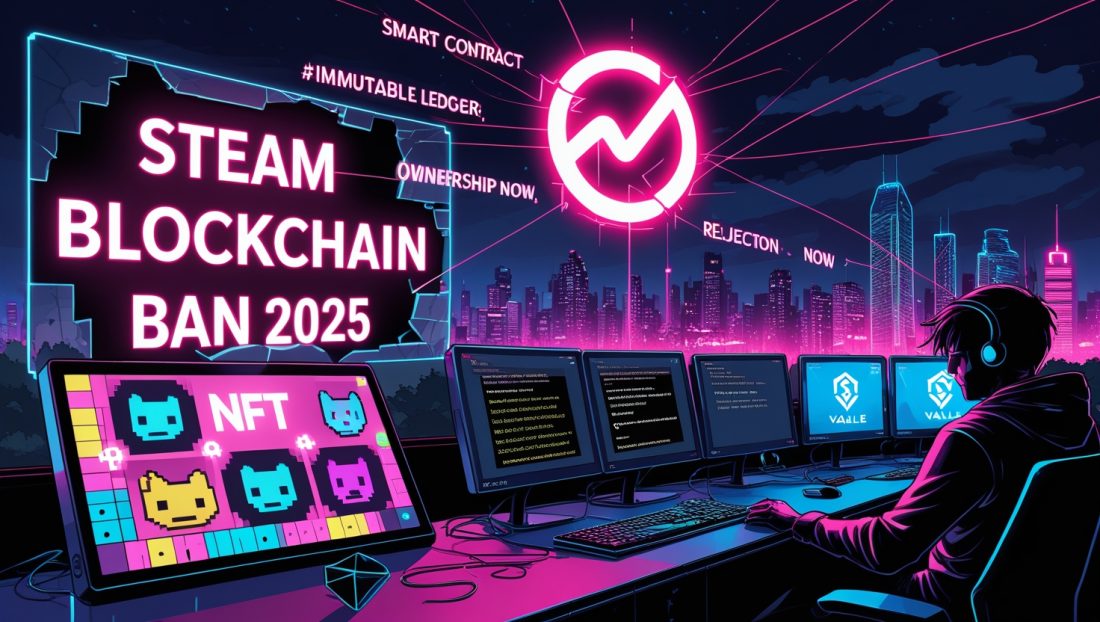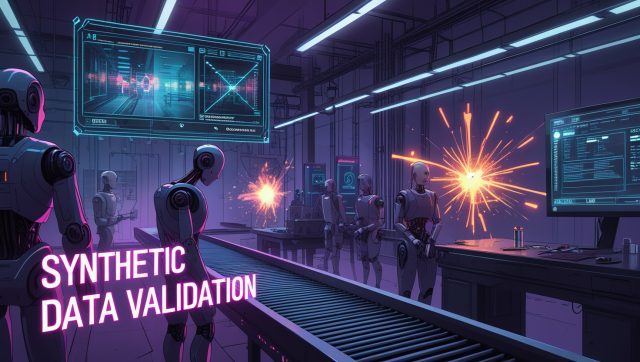Why would the world’s largest PC gaming platform ban a technology revolutionizing digital ownership? Valve’s 2021 prohibition of blockchain games—still enforced in 2025—has backfired spectacularly. Instead of containing the technology, the Steam blockchain ban fueled a $73 billion industry and a gamer uprising threatening Steam’s dominance. This is the story of a policy war, corporate rivalries, and players demanding control over their digital futures.
The Ban That Backfired: Origins and Immediate Fallout
In October 2021, Valve quietly updated Steam’s onboarding guidelines to prohibit “applications built on blockchain technology that issue or allow exchange of cryptocurrencies or NFTs.” The policy surfaced when SpacePirate Games shared its rejection notice for Age of Rust, citing Valve’s stance: “Items have value and [we] don’t allow items that can have real-world value on our platform.”
Valve’s rationale centered on three fears:
- Fraud Epidemic: Projects like Evolved Apes vanished with $2.7 million weeks after launch, epitomizing “super sketchy activity,” as Gabe Newell noted in 2022.
- Legal Vulnerability: Steam’s history with CS:GO skin gambling lawsuits made NFTs a liability minefield.
- Volatility: NFT markets crashed by 90% from their May 2021 peaks, risking financial harm to players.
Epic Games seized the opportunity within hours. CEO Tim Sweeney declared: “Epic Games Store will welcome games that make use of blockchain tech provided they follow relevant laws.” This strategic divergence positioned Epic as the innovation haven while the Steam blockchain ban painted Valve as reactionary.
The 2025 Rebellion: By the Numbers
- Market Surge: Blockchain gaming ballooned to $73 billion by 2025, with daily users exceeding 4.2 million.
- Developer Exodus: 29 studios, including the Blockchain Gaming Alliance, petitioned Valve to reverse the Steam blockchain ban, arguing blockchain “enhances user experience and creates economic opportunities.”
- Platform Shift: Major titles like Blankos Block Party (Epic) and gods Unchained (Immutable X) bypassed Steam entirely.
Table: Blockchain Gaming Growth Post-Steam Ban
| Metric | 2021 | 2025 |
|---|---|---|
| Market Value | $4.2 billion | $73 billion |
| Daily Active Users | 500,000 | 4.2 million |
| Play-to-Earn Revenue | $300 million | $3.5 billion |
Case Study: Off The Grid Cracks Steam’s Armor
Gunzilla Games’ battle royale Off The Grid achieved the impossible in June 2025: a blockchain game launch on Steam. Its solution exposed the flaws in the Steam blockchain ban:
- Steam-Compliant Version: All NFT elements (tradable weapon skins, character limbs) were stripped from the Steam build.
- External Blockchain: Players link third-party wallets via Gunzilla’s site, using Avalanche subnets for transactions.
- Cross-Play: Steam users battle NFT owners on PlayStation/Xbox, unaware of the parallel economy.
Gamers immediately questioned the hypocrisy. “Will the Steam version even have limbs and guns for loadouts?” asked user Merc on X. Valve remained silent, but Off The Grid’s success—500,000 pre-orders on Steam—proved demand couldn’t be suppressed by the Steam blockchain ban.
Why Gamers Revolted: Ownership, Value, and Betrayal
The Ownership Revolution
Blockchain enables true digital ownership. When servers shut down, NFTs persist—unlike Steam-purchased skins. Axie Infinity demonstrated this power during the pandemic: Filipino players earned $1,500 monthly breeding creatures, surpassing local wages. The Steam blockchain ban blocked this economic empowerment, igniting fury. As Reddit user u/DigitalSovereign argued: “Why can Valve profit from $50,000 CS:GO knives but ban my NFT spaceship?”
The Steam blockchain ban has sparked a fierce push for digital ownership, a concept that resonates deeply with gamers tired of losing access to their purchases. Blockchain technology ensures assets like in-game skins or characters remain player-owned, even if a game’s servers go offline. For example, The Sandbox lets players trade virtual land as NFTs, creating real-world value that persists across platforms.
This shift, stifled by the Steam blockchain ban, has driven players to platforms like Immutable X (a do-follow link to a leading blockchain gaming platform), which offers gas-free NFT trading and true ownership. In 2025, gamers are rallying behind titles like Illuvium, where players can sell earned assets for profit, highlighting how the Steam blockchain ban alienates a generation craving control over their digital investments.
Indie Developer Betrayal
Steam built its empire on indies (Hollow Knight, Stardew Valley), yet blockchain studios faced instant exile. Synesis One pivoted to Immutable X after rejection despite innovative AI mechanics. The hypocrisy stung: Steam’s Community Market thrives on artificial scarcity while banning NFTs for similar “real-world value” claims.
The Steam blockchain ban has alienated indie developers who once saw Steam as a haven for innovation. Indies like Hollow Knight thrived on Steam’s open platform, but blockchain studios face outright rejection, even when their games prioritize gameplay over monetization. Synesis One’s pivot to Immutable X shows how the Steam blockchain ban pushes talent elsewhere, costing Valve market share.
Platforms like Epic Games Store (a do-follow link to Epic’s blockchain-friendly marketplace) now attract these developers with open policies and revenue-sharing models. In 2025, the Steam blockchain ban risks turning Valve into a gatekeeper that stifles the very creativity it once championed, forcing indies to seek platforms that embrace their vision.
Missing the Metaverse Shift
By 2025, interoperability became gaming’s holy grail. Platforms like Enjin let NFTs traverse games—a sword earned in Illuvium could be sold in Decentraland. Steam’s walled garden felt archaic. As one X user warned: “Steam’s acting like Blockbuster ignoring Netflix.”
The Steam blockchain ban has left Valve lagging in the race toward interoperable gaming ecosystems, where assets flow seamlessly between virtual worlds. Enjin’s multiverse vision, for instance, allows a single NFT to function across dozens of games, creating a dynamic economy that players crave. The Steam blockchain ban blocks this future, keeping Steam isolated while competitors embrace the metaverse.
Platforms like Decentraland enable players to own and trade assets across games, a model gaining traction in 2025. By clinging to its restrictive policy, the Steam blockchain ban risks making Steam irrelevant to Gen Z gamers who prioritize cross-platform ownership and flexibility.
Blockchain’s Double-Edged Sword: Promise vs. Perils
The Promise: Player Empowerment
- True Ownership: Resell items without publisher cuts (e.g., Decentraland virtual real estate sales).
- Play-to-Own Models: gods Unchained replaced exploitative “play-to-earn” with sustainable card ownership.
- Cross-Game Economies: Enjin’s multiverse project enables NFT portability across 50+ games.
The Perils: Scams and Sustainability
- Rug Pulls: Evolved Apes collapse ($2.7M stolen) validated Valve’s fraud concerns.
- Cheating Epidemics: MapleStory Universe’s Avalanche-based economy was wrecked by bots farming tokens in May 2025.
- Sustainability: While Ethereum’s 2022 shift to proof-of-stake reduced energy use 99%, stigma persists.
Epic’s Masterstroke: How Rivals Capitalized
Epic Games Store’s blockchain embrace paid dividends:
- Exclusive Titles: Blankos Block Party attracted 2 million players by 2023.
- Developer Loyalty: Light Nite migrated to Epic after Steam’s removal, calling Valve “anti-innovation.”
- Regulatory Savvy: Epic mandates KYC verification and age ratings, mitigating legal risks Steam feared.
Console makers followed suit. Off The Grid launched simultaneously on PlayStation 5 and Xbox Series X/S with full NFT features, leveraging console-makers’ controlled ecosystems to bypass the Steam blockchain ban.
Workarounds and Loopholes: Gaming the System
Developers devised ingenious Steam compliance strategies:
- “Lite” Versions: Evaverse hid blockchain behind external accounts, earning “Very Positive” Steam reviews from non-NFT players.
- Stealth Onboarding: MagicCraft used in-game links to external NFT marketplaces, avoiding Valve’s scrutiny.
- Tokenless Assets: Some games tokenized items off-chain, only recording ownership on blockchain during trades.
Table: Blockchain Games on Steam via Loopholes (2025)
| Game | Strategy | User Rating |
|---|---|---|
| Evaverse | External NFT linking | 89% Positive |
| MetaWorld | “Cosmetic-only” Steam build | 78% Positive |
| The Sandbox Lite | In-game currency conversion | 82% Positive |
The $182 Billion Question: Can Steam Afford to Hold Out?
Projections show blockchain gaming hitting $182 billion by 2034. With Off The Grid cracking Steam’s defenses and rivals gaining ground, Valve faces a dilemma:
- Revenue Loss: Steam forfeits 30% fees on billions in NFT trades occurring off-platform.
- Cultural Irrelevance: Gen Z gamers prioritize asset ownership—70% prefer games with resale economies (DappRadar 2024).
- Innovation Drain: Top Web3 developers like Gala Games now prioritize Epic and consoles.
Yet risks remain. Alleged scam projects like Paradise—accused of faking partnerships and exit schemes—prove Valve’s concerns weren’t unfounded.
The Path Forward: Adaptation or Obsolescence
For Steam:
- Allow opt-in NFT features with strict disclosure rules.
- Leverage Steam Wallet for blockchain transactions, regaining fee control.
- Curate vetted projects to exclude scams.
For Developers:
- Follow Off The Grid’s model: prioritize gameplay, make blockchain optional.
- Adopt carbon-neutral blockchains like Avalanche or Tezos.
- Implement anti-cheat systems proactively (unlike MapleStory Universe).
For Gamers:
- Demand transparency: Is that “rare skin” truly yours if servers die?
- Support ethical models: Avoid games with unsustainable tokenomics.
- Diversify platforms: Explore Epic, Gala, or Immutable X for true ownership.
The Reckoning
Valve’s Steam blockchain ban aimed to protect players. Instead, it catalyzed an industry Steam can no longer ignore. As Off The Grid launches on Steam without conceding its NFT vision, a new compromise emerges: games can satisfy Valve’s rules and deliver decentralization. The real betrayal isn’t Steam’s caution—it’s their refusal to evolve while gamers reinvent ownership without them.
The revolution isn’t coming. It’s logging in.



